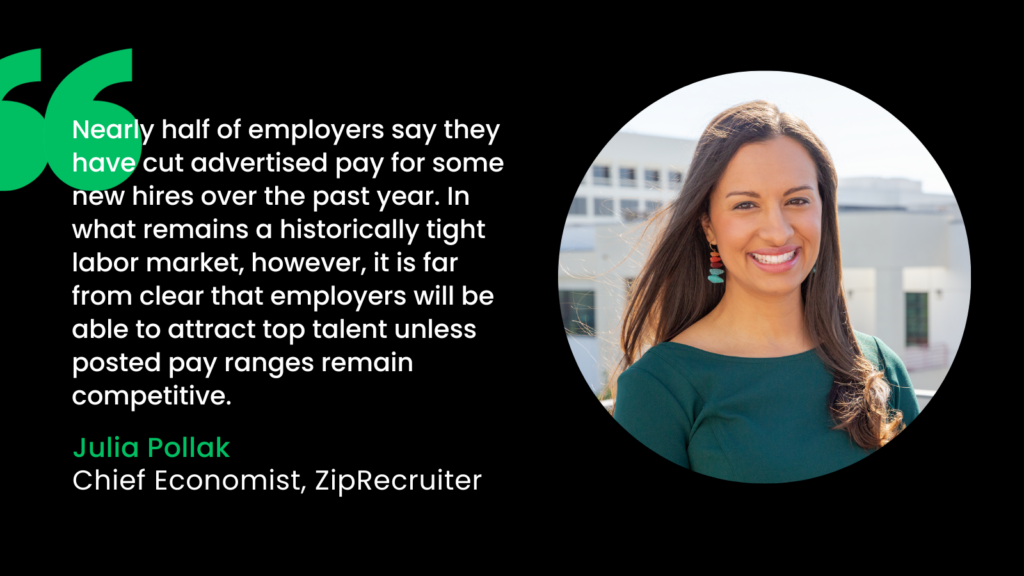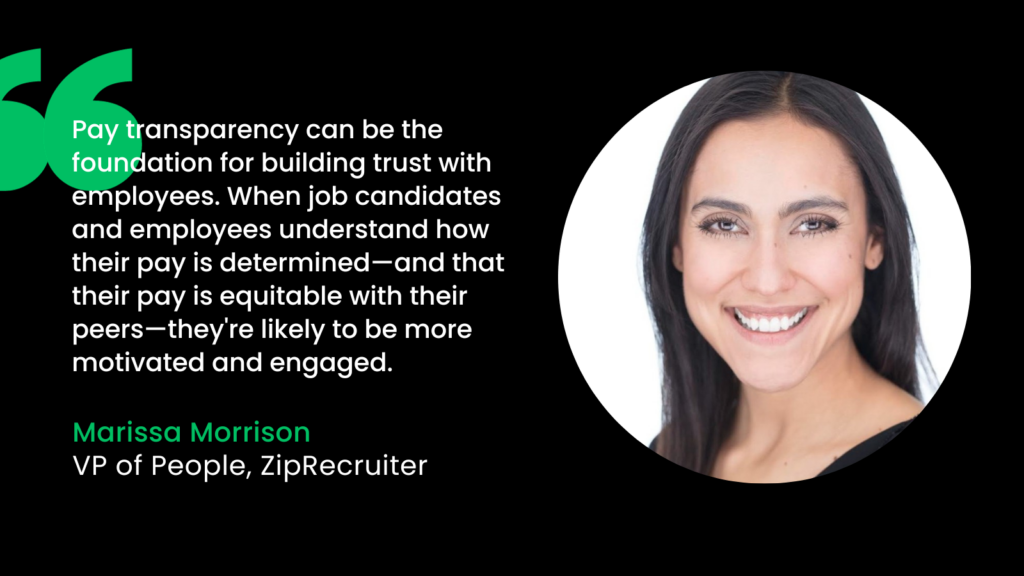The next findings are primarily based on the outcomes of ZipRecruiter’s first Annual Employer Survey, offering an in-depth look into the challenges, motivations, and newest hiring practices of employers throughout the U.S.
High takeaway: IT is changing into customary observe for employers to publish wage Information in job descriptions, however figuring out the suitable quantity to put up stays difficult. Virtually half of employers have diminished pay for sure roles over the previous yr, at the same time as 4 in 10 say they’re unable to fill vacancies at present wage ranges.
Pay transparency legal guidelines are driving extra employers to reveal wage ranges in job descriptions. That elevated transparency is making IT simpler to watch developments in employers’ wage presents. Proper now, the pattern is evident: development in marketed wage charges for brand spanking new hires just isn’t solely slowing— in some instances, IT’s reversing. In truth, over the previous yr, extra job titles, industries, and job classes on ZipRecruiter have seen common marketed wage charges decline than enhance, reversing the pattern in prior years.
To study extra about how companies are occupied with pay ranges and pay communications, ZipRecruiter’s latest annual employer survey requested a number of detailed questions. Employers reported that pay is the most necessary differentiator in recruitment and that they really feel stress from candidates to lift pay, with 41% of employers saying {that a} place has gone unfilled previously 6 months as a result of candidates need extra pay than the corporate is ready to supply. Nonetheless, employers are additionally attempting to vary worker wage expectations following two years of fast (nominal) wage will increase, with 48% saying they’ve reset pay downwards for some roles previously yr.
THE MACROECONOMIC BACKDROP
In keeping with information from the U.S. Bureau of Labor Statistics, the common hourly wage has risen 18.5% for the reason that pandemic1—no less than, in nominal phrases. Over the identical interval, client costs have risen by roughly the identical quantity,2 so the common actual wage has been roughly flat. Had inflation remained in line with the Federal Reserve’s 2% inflation goal, costs would have grown simply 7%, and wages 12% (by round 2% a yr to maintain tempo with inflation and an extra 1.4% per yr to compensate employees for increased productiveness).3 In actual phrases, then, the common wage now’s nearly 5% beneath its pre-pandemic pattern.
The result’s that many employers consider they’ve given employees unusually giant wage will increase for the reason that pandemic, and lots of employees consider they’ve seen their wages stagnate or fall. Each are proper, relying on how one accounts for inflation. Since wages and costs don’t develop evenly throughout classes and areas, the image is much more sophisticated, with some employees—significantly these in low-wage industries—popping out forward and others falling behind.
On the similar time that fast inflation and widespread labor shortages had been prompting employers to think about extraordinary one-time measures like giant signing bonuses and will increase to beginning pay, a number of states adopted pay transparency legal guidelines that require employers to publish the wage or wage vary they moderately anticipate to pay upfront in every job itemizing. The legal guidelines have inspired employers to overtake their pay insurance policies and undertake extra clear, strategic, and disciplined pay practices on the very second once they had the strongest financial incentive to do the alternative. We carried out our survey to discover how employers are resolving these tensions.

KEY FINDINGS
Transparency Issues
- Pay Transparency Now Customary Apply—The place Required. 72% of employers surveyed stated that they put up wage Information in all job postings, and solely 10% say they don’t. However the remaining 18% say they disclose pay solely in states the place legally required to take action. Small or medium-sized companies had been extra probably than main enterprises to say that they put up pay (74% vs. 64%). ZipRecruiter market information confirms that pay transparency legal guidelines drive a significant enhance in disclosure, elevating the share of postings with pay Information from round 20-30% earlier than the legal guidelines take impact to round 50-60% afterwards.
- Recruitment Advantages of Pay Transparency. 75% of employers agree that pay transparency helps them appeal to high quality candidates. 61% agree that pay transparency makes recruitment extra environment friendly by discouraging poorly matched candidates from making use of and stopping post-offer disappointment. ZipRecruiter market information confirms that job postings that embrace wage information obtain 50% extra purposes, on common,4 and are 3 times extra prone to ship high quality candidates.5
- Employer Apprehensions Relating to Transparency. 44% of employers fear that pay transparency may discourage prime expertise from making use of for his or her roles as a result of competitor corporations put up increased pay. Whereas employers wish to keep away from publicly posting excessive wage charges and setting expectations unrealistically excessive, additionally they don’t wish to set pay too low and deter high-quality candidates from making use of. Employers additionally fear that candidates who see base pay charges revealed may fail to know that complete compensation is usually considerably increased, as soon as advantages and perks are included. Amongst corporations that don’t disclose pay upfront, 71% solely achieve this in the midst of interviews the place they’ll present extra context.
- Pay Transparency and Pay Negotiations. 64% of employers general, and 75% of main enterprises, stated that candidates ceaselessly negotiate pay. 44% of employers fear that posting pay publicly may tie their arms in pay discussions and cut back their flexibility to barter with particular person candidates, slowing the recruitment course of down.
- The Stress Between Exterior Competitiveness and Inside Fairness. 44% of employers say they consider that pay transparency causes battle internally amongst present workers. When labor market circumstances are tight, employers face stress to lift posted pay charges to draw extra candidates. However doing so could cause incumbent workers to really feel unfairly handled if they don’t obtain comparable upward changes. A big share of employers are involved that transparency may make wage compression between new hires and longer-tenured workers extra salient and thereby hurt worker morale.
Pay Dynamics within the Present Market
- Job Seeker Wage Calls for. 41% of employers stated {that a} place has gone unfilled previously 6 months as a result of candidates wished extra pay than the corporate was ready to supply. That have was equally prevalent in main enterprises (44%) and small or medium-sized companies (40%).
- Resetting Expectations. 48% of corporations stated they’ve reset pay downwards for some roles over the previous yr. Small and medium-sized companies had been considerably extra probably than main enterprises to have lower pay (50% vs. 38%).
- From Pay to Perks. At the same time as nearly half of corporations have diminished pay for some roles, many have added advantages and perks. 39% stated they added Health insurance coverage advantages over the previous yr, 28% retirement advantages, and 26% life insurance coverage advantages. Employers’ self-reported habits is in line with ZipRecruiter job posting information displaying elevated mentions of advantages over the previous three years.

Notes
- U.S. Bureau of Labor Statistics, Present Employment Statistics, February 2020–August 2023, at https://fred.stlouisfed.org/series/AHETPI.
- U.S. Bureau of Labor Statistics, Shopper Worth Index, February 2020–August 2023, at https://fred.stlouisfed.org/series/CPIAUCSL.
- Between 2013 and 2019, employees grew to become accustomed to receiving a 2% annual enhance to maintain tempo with inflation, and an extra 1.4%3 annual enhance to account for productiveness development. Creator’s calculations utilizing U.S. Bureau of Labor Statistics, Present Employment Statistics, February 2020–August 2023, at https://fred.stlouisfed.org/series/AHETPI; and U.S. Bureau of Labor Statistics, Shopper Worth Index, February 2020–August 2023, at https://fred.stlouisfed.org/series/CPIAUCSL.
- ZipRecruiter Inside Knowledge, Jan.1 to Dec.31 2022. Contains Solely ZipApply subscriber Jobs.
- ZipRecruiter Inside Knowledge, Jan.1 to Dec.31 2022.
PAY TRENDS CHARTS

!operate(){“use strict”;window.addEventListener(“message”,(operate(a){if(void 0!==a.information[“datawrapper-height”]){var e=doc.querySelectorAll(“iframe”);for(var t in a.information[“datawrapper-height”])for(var r=0;r<e.size;r++)if(e[r].contentWindow===a.supply){var i=a.information["datawrapper-height"][t]+"px";e[r].fashion.top=i}}}))}();
!operate(){“use strict”;window.addEventListener(“message”,(operate(a){if(void 0!==a.information[“datawrapper-height”]){var e=doc.querySelectorAll(“iframe”);for(var t in a.information[“datawrapper-height”])for(var r=0;r<e.size;r++)if(e[r].contentWindow===a.supply){var i=a.information["datawrapper-height"][t]+"px";e[r].fashion.top=i}}}))}();
!operate(){“use strict”;window.addEventListener(“message”,(operate(a){if(void 0!==a.information[“datawrapper-height”]){var e=doc.querySelectorAll(“iframe”);for(var t in a.information[“datawrapper-height”])for(var r=0;r<e.size;r++)if(e[r].contentWindow===a.supply){var i=a.information["datawrapper-height"][t]+"px";e[r].fashion.top=i}}}))}();
Survey Methodology: ZipRecruiter carried out a nationwide on-line survey between July 7 and August 1, 2023, to discover employer attitudes towards latest hiring developments and their experiences of present U.S. labor market circumstances.
The survey was administered to a Qualtrics panel of two,000+ verified expertise acquisition professionals and hiring managers, every of whom has appreciable duty for hiring processes and selections. They had been drawn from companies of assorted sizes throughout a variety of industries.
Along with customary screening and demographic questions, respondents had been requested about their recruiting, hiring, employment, and retention practices, in addition to their expectations, wishes, and necessities for future expertise acquisition actions.